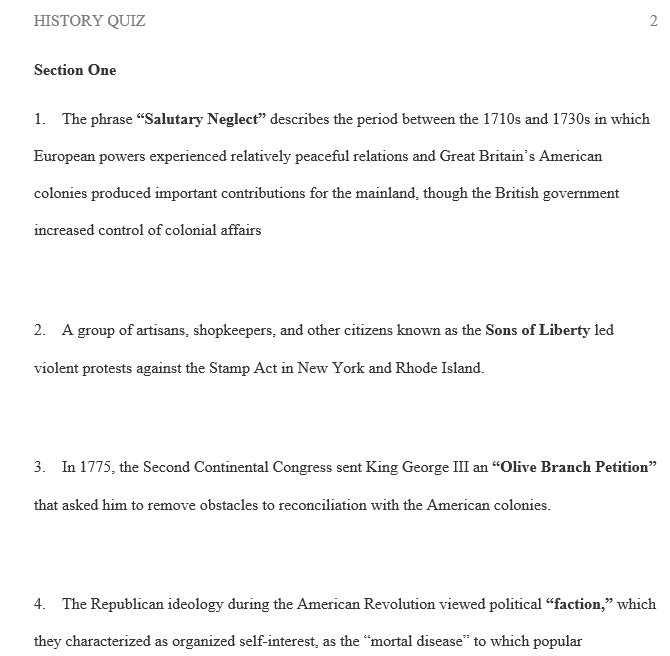Discuss some of the differences between Northern colonies and Southern colonies that developed during the 1600s and 1700s
Directions: Quiz #2 contains two parts. In the first part, type the answer that best completes the sentence or answers the question. In the second part, respond to each of the short answer questions in your own words.
1. The phrase “_______” describes the period between the 1710s and 1730s in which European powers experienced relatively peaceful relations and Great Britain’s American colonies produced important contributions for the mainland, though the British government increased control of colonial affairs.
2. A group of artisans, shopkeepers, and other citizens known as the _______ led violent protests against the Stamp Act in New York and Rhode Island.
3. In 1775, the Second Continental Congress sent King George III an “_______ Petition” that asked him to remove obstacles to reconciliation with the American colonies.
4. The Republican ideology during the American Revolution viewed political “_______,” which they characterized as organized self-interest, as the “mortal disease” to which popular governments throughout history had succumbed.
5. In 1781 Congress appointed _______ as superintendent of finance with the authority to deal with the national debt that the United States had incurred during the American Revolution.
6. In what month and year did the last of the thirteen original colonies ratify the Constitution?
7. At the end of George Washington’s presidency, were the likes of Thomas Jefferson, Alexander Hamilton, and Thomas Paine in agreement with, opposed to, or neutral toward Washington’s administration?
8. In the early 1800s, _______ explored the sources of the Mississippi River in Minnesota and led an expedition that ventured into the Rocky Mountains.
Section 2
1. The course textbook notes that a “growing rift” in the 1770s led to the American Revolution that eventually produced independence for the United States from Great Britain. When the War for American Independence broke out, both the British and the Americans maintained what they viewed as very significant reasons for going to war based on that rift that had developed between the two groups. Explain the reasons why each side went to war. In doing so, discuss two distinct reasons why the Americans justified war and two distinct reasons why the British justified war. Be sure that you explain why each reason helped to justify the war for its side. Also, be sure that your answer does justice to both sides – i.e., that you demonstrate understanding of why each side would see its reasons as significant and legitimate.
Please answer below:
.2. Students of history can examine the experiences of individuals who fought in the War for American Independence to understand some of the everyday characteristics and consequences of the war. Describe the general characteristics of the group of individuals who constituted the troops who fought on the American side in the War for American Independence. Provide three distinct characteristics that tend to define this group. Then, indicate two distinct specific reasons why these individuals fought in the war. Finally, describe what these individuals experienced as they fought in the war. Describe three distinct conditions that individuals faced as they fought in the war.
Please answer below:
3. Chapter 8 of the course textbook characterizes the opening years of the newly formed United States of America as “a period of trial and transition.” Identify and explain four distinct specific political, economic, and/or social tensions that occurred in the early years of the United States that contribute to the characterization of this period of trial and transition. For each tension, be clear in distinguishing the tension from the other three, in explaining specifically what occurred in the early years of the United States as a nation that demonstrated the tension, and in explaining clearly how the tension constituted a trial and/or a transition for the newly formed nation.
Please answer below:
4. Quiz 1 asked you to discuss some of the differences between Northern colonies and Southern colonies that developed during the 1600s and 1700s. Continue to evaluate these differences by indicating three distinct specific ways in which Northern states and Southern states differed at the time of the beginning of the United States of America as a nation. Be specific in noting each difference and in indicating how what occurred in the North differed from what occurred in the South. In doing so, refer to particular things that were occurring in each region in the late 1700s.
Please answer below:
5. Describe the major characteristics of the foreign policy of the United States upon its formation in the late 1700s. Indicate four distinct features of early U.S. foreign policy, with explanation for each feature of what ideas produced the feature of U.S. foreign policy and what particular actions taken (or not taken) by the early U.S. government reflected the feature of foreign policy.
Please answer below:
6. The course textbook states that “America’s fight for independence ushered in an extended age of revolution that, over the following half century, would see a king toppled and aristocratic privilege overthrown in France, republican reforms erupt throughout Europe, and independence movements undercut European imperialism in Haiti and Latin America” (153). With this in mind, explain how the U.S. revolution influenced the development of revolutions in Europe and in the Atlantic region. Identify and explain three specific and distinct ways in which the U.S. revolution influenced revolutions in Europe and the Atlantic. For each influence, clearly identify what specifically in these other revolutions demonstrates the influence of the U.S. revolution, clearly identify what feature(s) of the U.S. revolution provided that influence, and clearly and fully explain how those feature(s) of the U.S. revolution provided that influence.
Solution preview for the order on Discuss some of the differences between Northern colonies and Southern colonies that developed during the 1600s and 1700s
APA
2034 words
